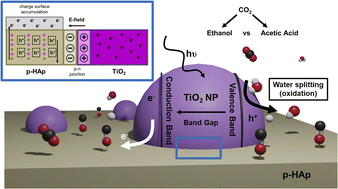Hydroxyapatite-based catalysts for CO2 fixation with controlled selectivity towards C2 products. Phenomenal support or active catalyst?†
Abstract
Permanently polarized hydroxyapatite (p-HAp) has been reported as a feasible green alternative to conventional catalysts for the selective conversion of CO2 into highly valuable chemical products. However, structural control and enhanced electrical properties achieved on p-HAp clearly contrast with other reported catalytic systems, where hydroxyapatite mainly acts as a support receiving much less attention. In this work we take advantage of the knowledge obtained on p-HAp to develop an HAp-based catalytic system composed of TiO2 nanoparticles deposited on p-HAp. It is important to stress that p-HAp is not only considered as a mechanical support but has been put in the spotlight for catalyst preparation and as an active catalytic part. Therefore, the use of p-HAp in this system has unveiled exceptional synergies with TiO2 attributed to the enhanced electrical properties of p-HAp, capable of attracting the photo-electrons generated in TiO2 nanoparticles avoiding electron–hole recombination. CO2 fixation reactions carried out under mild conditions (120 °C, 6 bar and under UV exposure) result in complete selectivity control of the C2 products, shifting from ethanol (201 μmol gcatalyst−1) for p-HAp alone to acetic acid (381 μmol gcatalyst−1) when TiO2 nanoparticles are loaded in the system. Considering the challenging CO2 activation energy and the high control of the selectivity achieved, we do believe that this novel approach can be considered as a starting point to explore other systems and reactions where control of the crystal structure and the enhanced electrical properties of HAp can play a crucial role in the final products, reaction conditions, yields and selectivities.



 Please wait while we load your content...
Please wait while we load your content...